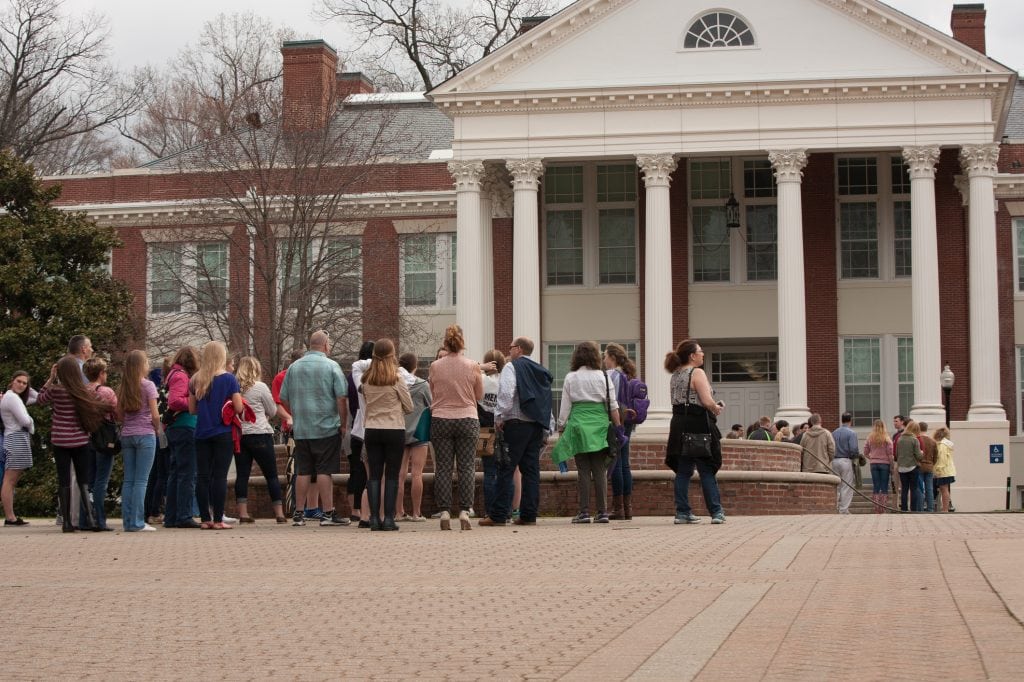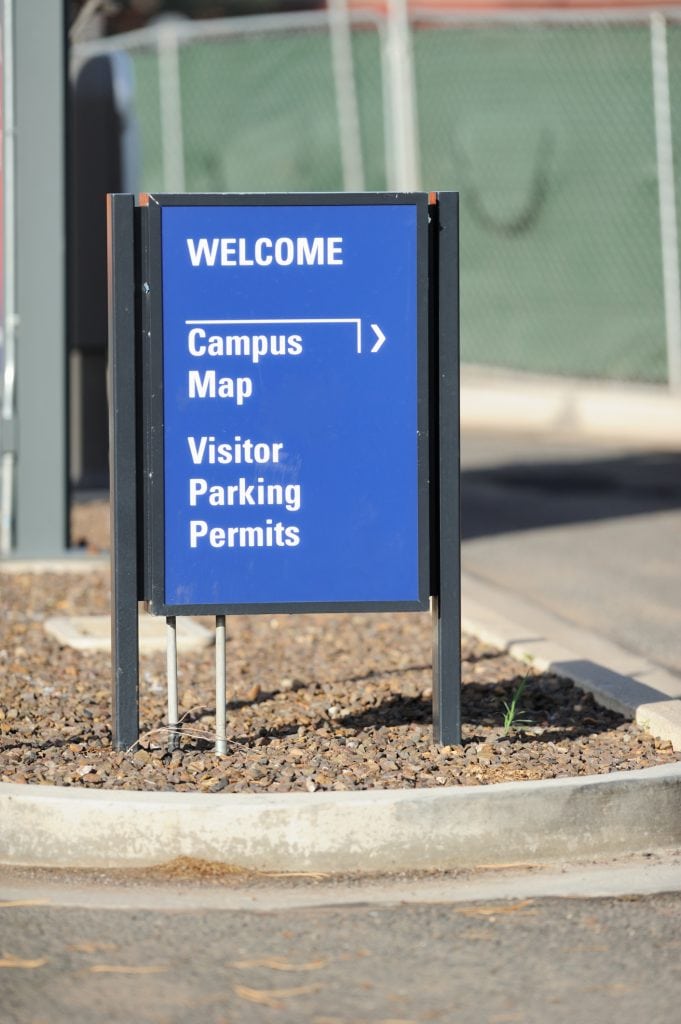
In the 2008 film “College Road Trip,” a sentimental dad and his determined daughter crash a hotel wedding, hitch a ride on a crowded tour bus and parachute from 25,000 feet onto the lawn of a major university campus, all in the name of visiting a few colleges. Your family doesn’t have to go to those lengths to check out institutions of higher learning, but there are a number of factors to consider when planning college visits.
Why College Visits are Important
Campus visits offer the chance to experience a school’s environment and learn firsthand about its programs while meeting current students. They are arguably the most effective way for students to evaluate whether they can envision themselves attending a school. Don Bush, a high school math teacher, regularly takes groups of students on college tours as part of his work as an educator and coordinator for Advancement Via Individual Determination (AVID), a national nonprofit that seeks to close the opportunity gap by preparing kids for the challenges of college.
Bush says kids are often surprised by their reactions to the schools they visit. It usually comes down to a gut feeling that students are only able to experience by setting foot on the campus. It’s important to reflect on that feeling and ultimately trust it. “Students intuitively know what’s right for them,” Bush says.
There are many aspects of a school, including the vibe of the campus and the level of diversity, that students can only become aware of by spending time on the premises. “The most effective way to learn about a school is to jump into the middle of the river rather than viewing it from the top of a cliff,” says Matt Fissinger, assistant vice provost for undergraduate admission at Loyola Marymount University. “College visits offer the opportunity to experience the energy of a campus and engage with its community.”
Checking schools out online is a poor substitute. “University websites include helpful virtual tours and other informational features, but the best way to really experience the college community and get a true sense of what that means, in addition to actually seeing the physical space, is to visit,” says Wes Sullivan, associate director of undergraduate admission at California Lutheran University.
With this in mind, my family set out to visit a number of colleges last year as our eldest son
 approached his senior year. There’s an art to maximizing the time spent on college tours and a number of steps families can take to ensure that these visits are helpful and worthwhile. Read on as we share what we learned while offering tips from the experts on how to make the most of your upcoming college road trip.
approached his senior year. There’s an art to maximizing the time spent on college tours and a number of steps families can take to ensure that these visits are helpful and worthwhile. Read on as we share what we learned while offering tips from the experts on how to make the most of your upcoming college road trip.
Developing a List of Schools
Counselors at a college-planning workshop we attended at Chaminade College Preparatory High School in West Hills recommended that students apply to at least 12 schools, aiming for a variety of sizes, locales and price points, and placing schools into three groups – safeties, targets and reaches. Once your student has a comprehensive list, try to visit as many campuses as you can, sectioning them into geographical groups. While families are most likely to tour students’ top choices, it’s also important to check out those that are lower on the list. “It’s remarkable how frequently kids end up becoming enthralled with a school that they didn’t expect to like,” says Cristina Trujillo, an AVID educator and social studies teacher. “On the other hand, we’ve had the experience of kids being less than thrilled about a dream school once they actually set foot on its campus.”
Because many schools require students to apply to a specific major, it’s also important that students have a good sense of the field of study they’d like to pursue. “Find out which colleges have a strong department in your chosen area of study,” says Elisabeth Keneally, a former academic counselor and instructor at Santa Monica College. “Once you’ve narrowed that down, look at the course offerings and requirements of the major to determine what areas of emphasis are offered and whether the focus is more on theory and research or application. These factors will help you choose programs to investigate that are in tune with your goals.”
Parents might have their own wish list of potential colleges to check out. It’s wise to offer those suggestions gently, along with practical reasons about why certain schools may warrant consideration. It’s vital to keep in mind that the student will be the one who’ll ultimately attend, and that a child’s success will largely depend on his or her comfort level at the school and the ability to fully become a part of the community, both academically and socially.
Planning a Workable Itinerary
As a result of our son’s full plate of extracurricular activities, we began touring colleges the summer after his junior year. This put us in crunch mode and forced us to adhere to a strict schedule. With some strategic planning and a big dose of perseverance, we managed to visit 15 schools in less than six weeks. It was a lot to digest in a short period of time.
A better bet is to take several mini-trips, preferably over the course of several years. Many students begin visiting colleges as early as sophomore year, which helps them avoid burnout. There are only so many times in one week that you can bear hearing about meal plans and intramural sports. After a while, the campuses start to blur together. For my daughter, a junior, we began visiting schools this year with plans to continue over the course of the next year. This will allow us to visit more schools while giving us an ample amount of time to reflect on each one.
Another crucial factor to keep in mind is the timing of your trip. “Summer is generally the most popular time to visit, when work and school schedules allow, but it’s really hard to take the pulse of a campus during breaks,” says Trujillo. Despite the fact that this will mean time away from school for your student, she suggests visiting when classes are in session to truly feel the energy of the school and experience how the campus operates during the academic year. Also, students who are contemplating attending a school with a different climate – extremely cold, snowy winters, for example – should visit during those times to make sure that they’re willing and able to handle unfamiliar seasonal patterns. Another benefit of going during the “off season” is that air fares and gas prices tend to drop a bit (except during the winter holidays), making these trips a bit more budget friendly.
Questions Worth Asking
College visits offer the unique opportunity for prospective students to talk to current students, as they are universally recruited to lead the tours. In addition to their prepared remarks, they’re trained to solicit questions at every turn. But what to ask? “Do your homework by researching the colleges you plan to visit,” advises Bush. “Avoid asking questions that are clearly addressed on the school’s website, focusing instead on obtaining tips and advice that students rely on to efficiently navigate campus life.” Bush suggests asking specific questions about the academic environment – whether professors are easily accessible, whether there are opportunities for tutoring and support and whether library and technological resources are readily available. Current students are also the ultimate resource for information on the atmosphere in the dorms, dining options after hours and other lifestyle aspects of the campus. Take advantage of the chance to get firsthand information on these and other topics.
Families should also avail themselves of options beyond the standard group tour. Sullivan says that Cal Lutheran, for example, provides opportunities for students to gain information on an individual level by meeting with professors, attending classes and talking with coaches, giving them a chance to essentially “try before they buy.”
Departments that provide support services to students can also be a gold mine for practical information. “Set aside time to meet with financial aid reps to talk about your specific situation and learn about available scholarships, grants, loans and work-study opportunities that can help fund your education,” suggests Keneally. Head to the career center to ask about the nature of job counseling and connections the university has established to help students gain internships and permanent positions. “Get a sense of where their graduates end up – what percentage are able to immediately find jobs in their field and what percentage of those who apply to graduate school are admitted,” says Bush.
Fringe Benefits
Traveling to and from your campus visits, whether by plane, train or automobile, provides built-in time for in-depth conversations with your child that your regular daily routine may not normally permit. Visits to colleges can therefore double as meaningful bonding opportunities. Threading in visits with family and friends, along with some sightseeing, can enrich the journey and further infuse it with fun and adventure. Exploring the larger environment surrounding the college can also help inform your visit and subsequent decisions about a school.
We took advantage of these perks during our fast-paced expedition last summer. After visiting Stanford, we wandered through the peculiar Winchester Mystery House and had a hearty lunch at Hobees, a local favorite. We visited several family members when we toured the University of San Francisco and Santa Clara University, and thoroughly enjoyed spending time with them while checking out local museums and points of interest. More recently, my daughter and I toured UC Riverside and stayed at the historic Mission Inn, a historic landmark with Spanish-style elegance. We had a blast reading about all of the dignitaries who’d spent time there, including Booker T. Washington, Albert Einstein and Amelia Earhart, proving that college road trips can be educational in more than one way.
Ending on a High Note
Following each college visit, consider sending a thank-you note or email to the admissions office and to any helpful contacts you made while on campus. While the next steps – completing the actual applications and waiting for responses – may provoke some anxiety, head into the process knowing that your family did its due diligence in educating and preparing your student to make an informed decision.
The college admissions process revolves around three distinct junctures. In the first, students hold the power of choosing where to apply. In the second, schools select who to admit. In the third, students step back into their power by choosing where they’ll attend. “For most of the process, the student is the one who holds sway over the final outcome,” says Fissinger. “The season of exploring colleges, applying to schools and ultimately selecting a campus can be enjoyable if families approach the process with a sense of confidence and control.”
Kimberly Lee left the practice of law some years ago to focus on motherhood, community work and creative pursuits. Her work has appeared in (mac)ro(mic), The Satirist, Literary Mama’s Blog, Toasted Cheese and Indiana Voice Journal, among others. She lives in Southern California with her husband and three children (one of whom just flew the coop to Cal Poly Pomona).



























